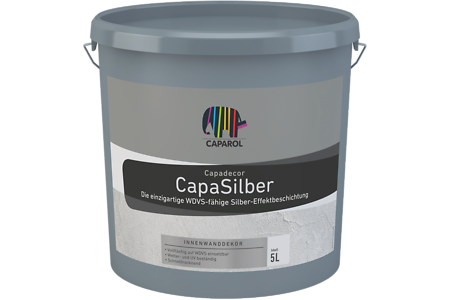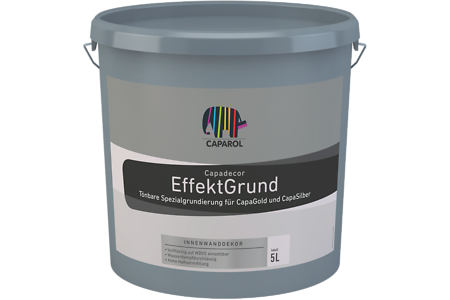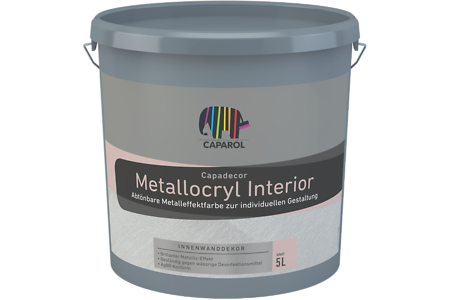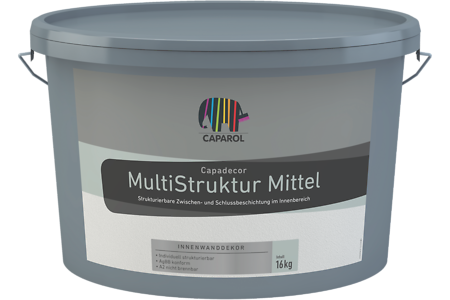Field of Application
The special effect coatings CapaGold and CapaSilber (CapaSilver) provide for a pure, natural gold or silver-coloured shade, particularly on textured surfaces, when used in combination with special primer EffektGrund. Individual surfaces with an attractive visual appearance are achievable with different application techniques, e.g. using paint brush, stippling board, scraper/wiper or paint roller.The required coating system (priming, intermediate and finishing coat) realises impressive surfaces with a high load capacity and is applicable on the full surface of ETICS/EWI systems.
Material Properties
- Highly pure, natural gold or silver colours.
- Applicable on the full surface of ETICS/EWI systems.
- Weather-resistant and resistant to UV light exposure.
- Fast-drying.
- Wet scrub resistance Class 1, corresponds to "scrub resistant" as per German standard DIN 53778.
Material Base / Vehicle
Pure acrylic dispersion/emulsionPackaging/Package Size
1.25 litres, 2.5 litres, 5 litresColours
Gold and silver
Gloss Level
Gloss to satin-/semi-gloss (mid sheen), depending on the substrate absorbency.Storage
Keep in a dry, cool, but frost-free place.
Minimum shelf life of original, tightly closed container: 1 year.
Density
Approx. 1.1 g/cm3Maximum grit size
< 100 µm, S1Dry film thickness
50 - 100 µm, E2Resistance-count for diffusion µ (H2O)
Rate of water permeability: 0.01 [kg/(m2 · h0,5)] (low), W3Diffusion-equivalent air layer thickness sdH2O
Water vapour permeability (sd-value): 0.64 m (medium), V2Supplementary Product
EffektGrundSuitability according to Technical Information No. 606 Definition of Application Areas
| Interior 1 | Interior 2 | Interior 3 | Exterior 1 | Exterior 2 |
| + | + | + | + | + |
| (–) inapplicable / (○) of limited suitability / (+) suitable | ||||
Suitable Substrates
Renders/plasters in mortar groups PII and PIII, existing render coatings, sound/stable synthetic, silicate or silicone resin paints, ETICS NEW and existing surfaces.The substrate must be sound/stable, dry, clean and free from all substances that may prevent good adhesion. In Germany: Follow VOB, part C, DIN 18363, section 3.
On smooth substrates with contrasting colours: One previously applied priming coat of Capadecor DecoGrund is advisable, when semi-transparent/translucent coatings of CapaGold or CapaSilver (Capasilber) are to be applied.
Substrate Preparation
Exterior SubstratesRenders/Plasters in Mortar Groups/Classes PII (Lime-Cement Mortars) and
PIII (Cement Mortars) / Minimum Compressive Strength according to DIN EN 998-1: 1.5 N/mm2:
New renders/plasters must be left untreated for a sufficiently long time, normally for 2 weeks at 20 °C and 65 % relative humidity. Adverse weather conditions, influenced e.g. by wind or rain, extend the curing process and correspondingly longer holding times must be respected. The risk of calcareous efflorescence is reduced by an additional priming coat of CapaGrund Universal and the alkaline finishing render/plaster may be coated after a holding time of 7 days.
Existing Renders/Plasters:
Repairs must have adequate time to cure and dry. Prime highly porous, absorbent, slightly sanding renders/plasters with OptiGrund or CapaSol. Apply one priming coat of Dupa-grund on highly sanding, chalking surfaces. Mineral lightweight renders/plasters of MG PII cannot be coated with CapaGold/CapaSilver.
Concrete:
Concrete surfaces with deposits of dirt or fines (sintered layer) must be cleaned by mechanical means or with high-pressure water jet, in compliance with the regulations. Apply one priming coat of EffektGrund on slightly absorbent or smooth surfaces. Apply one priming coat of OptiGrund or CapaSol on strongly absorbent surfaces. Prime chalking surfaces with Dupa-grund.
Sound/Stable Coatings of Enamel or Emulsion Paint:
Roughen (sand) glossy surfaces and enamels. Clean soiled, chalking coats of paint by pressure water jet, manual wet cleaning or other suitable means, in compliance with the regulations. Apply one priming coat of EffektGrund.
Existing Stable Coats of Plasto-Elastic Emulsion Paint, e.g. Cap-elast:
Cannot be coated with CapaGold/CapaSilver.
Sound/Stable Synthetic Resin-Bound (Organic) Renders/Plasters:
Clean existing renders/plasters by suitable means, in compliance with the regulations. Allow wet cleaned surfaces to dry thoroughly before further treatment. Apply one priming coat of EffektGrund.
Unstable Coatings of Enamel, Emulsion Paint or Synthetic Resin-Bound (Organic) Render/Plaster:
Remove completely by suitable means, e.g. mechanically or via paint stripper, followed by surface cleaning with a high-pressure steam jet, in compliance with the regulations. Apply one priming coat of EffektGrund. Apply one priming coat of Dupa-grund on strongly absorbent, sanding surfaces.
Unstable Coats of Mineral Paint:
Remove the coating completely by sanding off, brushing off, scraping off, using high-pressure water jet in compliance with the regulations, or use other suitable methods. Allow wet cleaned surfaces to dry thoroughly before further treatment. Prime with Dupa-grund.
Wood/Timber, Zinc/Galvanised Substrates, Unplasticized (Rigid) PVC:
Cannot be coated with CapaGold/CapaSilver.
Coil Coatings:
Use an ammonia potash based wetting agent for cleaning. Prime with e.g. Capacryl Haftprimer.
Note: Silicone containing coil coatings cannot be coated. Silicone content is not noticeable, hence always check for compatibility by coating a test area on site, followed by a test of adhesive tensile strength.
Facing Brickwork:
Only absorbent clinker bricks of frost resistant quality and free of foreign inclusions are suitable for exterior coatings. Masonry must be dry and free of salts/salty efflorescence, jointing must be free of cracks. Apply one priming coat of Dupa-grund. If brown discolouration appears on the intermediate coat CapaGold/CapaSilver cannot be used: recoat with solvent-based facade paint Duparol.
Surfaces Contaminated with Factory Fumes or Soot:
Cannot be coated with CapaGold/CapaSilver.
Surfaces with Fungal (Fungi/Mildew/Mould) or Algal Attack:
Clean by wet blasting in compliance with local regulations, then use Capatox or FungiGrund and allow to dry thoroughly.Cracks in Renders/Plasters and Concrete:
Cracks must always be repaired (removed) before using CapaGold/CapaSilver.
Surfaces with Salty Efflorescence:
Remove salty efflorescence thoroughly by dry wire brushing and prime with Dupa-grund. Coating of such surfaces must be considered a risk for which we cannot accept responsibility, since even after the most thorough treatment the efflorescence may recur.
Defects:
Repair small defects in mineral substrates with fine filler Caparol Fassaden-Feinspachtel, deeper damages up to 20 mm preferably with filler Histolith-Renovierspachtel and prime repaired areas subsequently.
ETICS/EWI System NEW:
Thermal insulation boards (Dalmatiner or EPS boards) of ETICS/EWI system type B: CapaGold and CapaSilver are applicable on full surfaces of the following system configuration:
Reinforcement layer: Capatect-Klebe und Spachtelmasse 190; Capatect-ZF-Spachtel 699 or Capatect CarbonSpachtel.
Fabrics: Capatect-Gewebe 650/110
Priming coat: Apply Putzgrund 610 onto Capatect-Klebe und Spachtelmasse 190 before applying exterior render (Fassadenputz).
Finishing render: Capatect AmphiSilan or ThermoSan NQG Fassadenputz K15, K20, K30 or R20, R30.
For completion of ETICS/EWI system type B, please follow the corresponding product information.
Note: Felted or smooth surfaces of ETICS/EWI systems are not enabled for being coated with CapaGold or CapaSilver.
ETICS/EWI System OLD:
(Requirement: Heat/thermal insulation must be completed using EPS boards and must be sound/stable and solid.)
Note: Only partial areas (max. 20 %) of existing ETICS can be coated with CapaGold/CapaSilver. Prepare these partial areas as described below:
After having completed all necessary preparations, the system configuration on renders/plasters in mortar group PII and on sound/stable organic, silicate and silicone resin renders/plasters (see Technical Information Suitable Substrates), has to be effected as follows:
Reinforcement layer: Capatect-Klebe und Spachtelmasse 190
Fabrics: Capatect-Gewebe 650/110
Priming coat: Putzgrund 610
Finishing render: Capatect AmphiSilan or ThermoSan NQG Fassadenputz K15, K20, K30 or R20, R30.
For completion of ETICS/EWI system type B, please follow the corresponding product information.
Note: Felted or smooth surfaces of ETICS/EWI systems are not enabled for being coated with CapaGold or CapaSilver.
Full surface application under the above mentioned criteria (ETICS NEW) is possible in case of an EnEV✱ conform energetical retrofitting of old ETICS by an additional layer of new ETICS.
✱ German regulation for energy saving in buildings and building systems
Interior Substrates
Plasters in Mortar Groups/Classes PII and PIII / Minimum Compressive Strength according to DIN EN 998-1: 1.5 N/mm2:
Solid plasters with normal absorbency require no preliminary treatment. Prime highly porous, sanding or absorbent plasters with OptiGrund or CapaSol.
Gypsum Mortar and Ready-Mixed Gypsum Plasters of Mortar Group/Class PIV / Minimum Compressive Strength according to DIN EN 13279: 2 N/mm2:
Sand/grind sintered surfaces, remove all sintered skin and sanding dust, then apply one priming coat of Caparol-Tiefgrund TB.
Gypsum Wallboards:
Prime absorbent boards with OptiGrund or Caparol-Tiefgrund TB.
Plasterboards (Sandwich-Type Plaster Boards/Drywalls):
Sand/grind off filling burrs. Prime and strengthen soft gypsum areas (repairs) with Caparol-Tiefgrund TB. Boards containing water-soluble and discolouring substances that leave marks must be primed with Caparol AquaSperrgrund. In Germany: Follow BFS Data Sheet No. 12.
Concrete:
Remove all residues of separating agents (formwork oil residues) and chalking or sanding substances.
Autoclaved Aerated Concrete (AAC)/ Cellular Concrete:
Prime with a 1 : 3 mixture of Capaplex and tap (potable) water.Facing Brickwork and Fair-Faced Sand-Lime Masonry:
Coat without any pre-treatment.
Sound/Stable Existing Coatings:
Matt (flat), slightly absorbent coatings may be treated without a preliminary preparation. Roughen glossy surfaces and enamel coatings.
Unstable Existing Coatings:
Remove unstable enamels and emulsion paints or synthetic (organic) plasters. Slightly absorbent, smooth surfaces can be directly coated. Prime highly porous, sanding or absorbent surfaces with OptiGrund or CapaSol. Remove unstable mineral coatings by mechanical means and remove all sanding dust. Then prime with Caparol-Tiefgrund TB.
Glue-Bound Distemper (Limewater Colour/Paint):
Remove by washing and prime with Caparol-Tiefgrund TB.
Unpainted Woodchip/Ingrain, Relief or Embossed Wallpapers:
Coat without any pre-treatment.
Non-Adherent Wallpapers:
Remove completely. Wash off all residues of wallpaper paste and waste paper.
Prime with Caparol-Tiefgrund TB.
Mildewed Surfaces:
Remove coverings of mould by wet cleaning, then use Capatox or FungiGrund and allow to dry well.
Surfaces Stained with Nicotine, Water, Soot or Fat/Grease:
Remove nicotine, soot or fat/grease stains by washing with tap water, adding a fat-dissolving household detergent, then allow the substrate to dry well. Clean dried-up water stains by dry brushing. Apply one insulating coat of Caparol AquaSperrgrund.
Wood and Derived Timber Products:
Cannot be coated with CapaGold/CapaSilver.
Small Defects:
After having completed suitable preparatory work, repair small defects with filler Caparol-Akkordspachtel, following the manufacturers’ instructions for processing.
Prime subsequently, if necessary.
Method of Application
Stir up very thoroughly before use and stir repeatedly during application. Apply the product with paint brush or roller, depending on the texture/structure of the substrate. Trimming areas should be rolled again. Always work wet-on-wet. Use medium pile rollers (pile height: 12-16 mm) without tendency of material accumulation in their border area.
Roller application (only advisable for coarser textured renders): Apply CapaGold/CapaSilver evenly, spread across and roll over in one direction to obtain a uniform alignment of the metallic effect pigments.
On smooth, finely-textured substrates the applied product should be treated with a creative application technique (using brush, stippling brush, filling, etc.).
Thinning
Apply undiluted product.Surface Coating System
Intermediate Coat:Apply one covering coat of Capadecor EffektGrund (Technical Information No. 814) evenly and liberally onto the prepared substrate. The primer should be tinted in a matching colour shade according to ColorExpress colour collection "CD EffektGrund". Apply EffektGrund according to the desired visual effect.
Finishing Coats:
Apply two coats of undiluted CapaGold/CapaSilver. Equalize all roller marks on smooth surfaces, either with a brush or using other suitable creative tools.
Consumption
Approx. 100 - 150 ml/m2 per coat.Consumption is highly influenced by the substrate condition (roughness, absorbency).
Determine the exact amount of material required by coating a test area on site.
Drying/Drying Time
At +20 °C and 65 % relative humidity dust-dry after approx. 1 hour, recoatable after approx. 12 hours. Lower temperatures, higher humidity and a high consumption may extend the drying time.
Tool Cleaning
Immediately after use with water.Note
CapaGold/CapaSilber can be applied as semi-transparent (translucent) coat, e.g. on MultiStruktur or Capaver FantasticFleece. For this purpose the intermediate coat of EffektGrund is omitted.German Certificates
- Durability test (exteriors): Bewertung der Dauerhaftigkeit im Außenbereich
Please Note (Status as at Date of Publication)
Keep out of reach from children. Ensure good ventilation during use and drying. Do not eat, drink or smoke while using the paint. In case of contact with eyes or skin, immediately and thoroughly rinse with water. Do not allow product to enter drains, waterways or soil. Clean utensils immediately after use with soap and water. Do not breathe spray dust.Further information: See Material Safety Data Sheet (MSDS).
Contains: 1,2-benzisothiazol-3(2H)-one, 2-methyl-2H-isothiazol-3-one. May produce an allergic
reaction.
In Germany: Advice for allergy sufferers with isothiazolinone allergy: German hotline 0180/5308928
(0.14 €/minute from German landline, MTS max. 0.42 €/minute).
Disposal
Materials and all related packaging must be disposed of in a safe way in accordance with the full requirements of the local authorities. Particular attention should be made to removing wastage from site in compliance with standard construction site procedures.In Germany: Only completely empty containers should be handed in for recycling. Dispose containers with residues of liquid product via waste collection point accepting old paints and enamels. Dispose dried/hardened product residues as construction site/demolition/municipal or domestic waste.
EU limit value for the VOC content
of this product (category A/c): max. 40 g/l (2010). This product contains max. 35 g/l VOC.Product Code Paints and Enamels
M-DF02 (Germany)Substances of Content - Declaration
Polyacrylate resin, (metallic) effect pigments, silicates, water, glycol ether, additives, preservative (methylisothiazolinone, benzisothiazolinone).Further Details
CapaSilver / German product name: CapaSilberTechnical Assistance
As it is impossible to list herein the wide variety of substrates and their specific problems, please request our technical assistance in case of queries. We will describe appropriate working methods, if a substrate not specified above is to be coated.Customer Service Centre
Tel.: +49 06154- 71 7 1710Fax: +49 05154- 71 7 1711
e-mail: kundenservicecenter@caparol.de
International Distribution: Please see www.caparol.com









